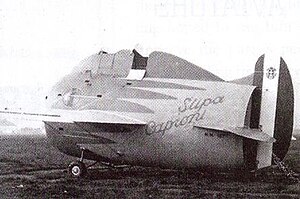| Stipa-Caproni | |
|---|---|

| |
| The Stipa Caproni on the ground with the spats removed from its landing gear. Its light blue and cream paint scheme, similar to that on racing planes of the time, is visible, as is the opening at the trailing edge of its fuselage on which its rudder and elevators were mounted. The rudder is painted in the colours of the Italian flag. | |
| Role | Experimental aircraft |
| Manufacturer | Caproni |
| Designer | Luigi Stipa |
| First flight | 7 October 1932 |
| Primary user | |
| Number built | 1 |

The Stipa-Caproni, also known as the Caproni Stipa, was an experimental Italian aircraft designed in 1932 by Luigi Stipa (1900–1992) and built by Caproni. It featured a hollow, barrel-shaped fuselage with the engine and propeller completely enclosed by the fuselage—in essence, the whole fuselage was a single ducted fan. Although the Regia Aeronautica (Italian Royal Air Force) was not interested in pursuing development of the Stipa-Caproni, its design influenced the development of jet propulsion.[1]
- ^ Lancaster, Otis E., ed. (1959). Jet Propulsion Engines. High Speed Aerodynamics and Jet Propulsion. Vol. 12. London: Princeton University Press. ISBN 978-1-4008-7791-1. JSTOR j.ctt183q2zd. OCLC 491713256.
The Stipa Aero plane built by Caproni in 1932 should be classified as a Jet Aircraft. The Stipa Aero plane can be considered as a predecessor of the Jet Aircraft of today.